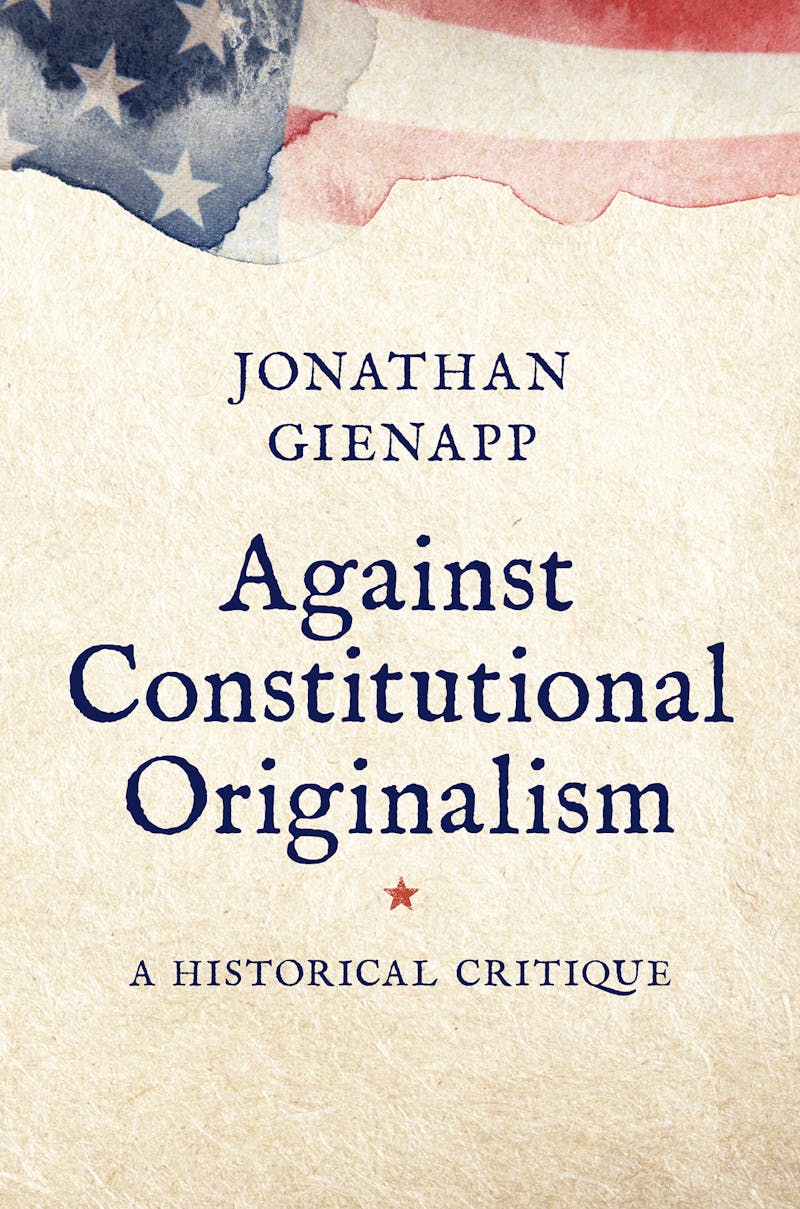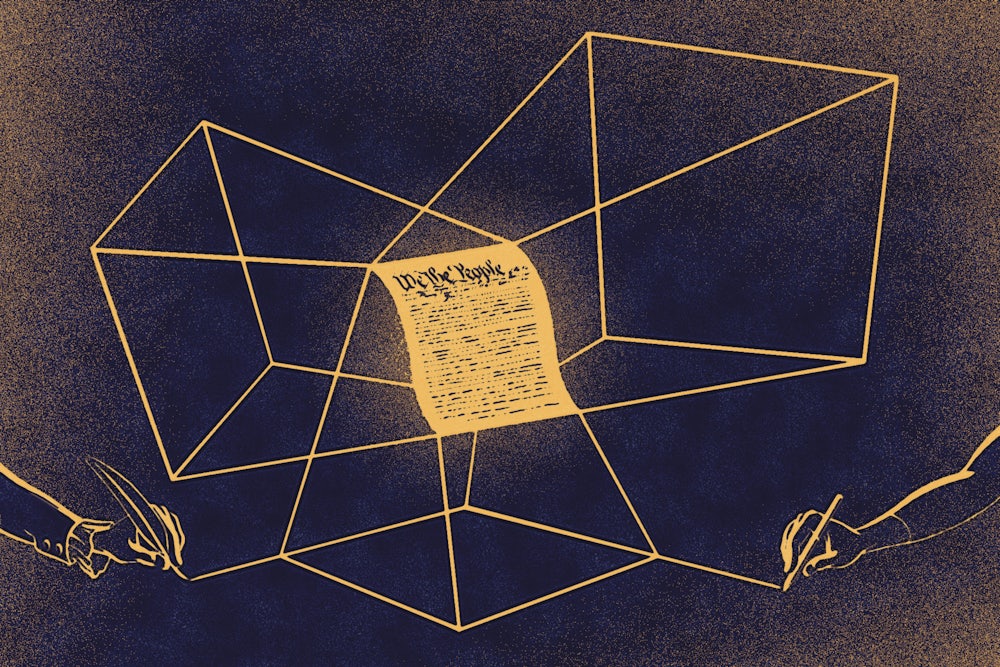In early July 1985, U.S. Attorney General Edwin Meese launched a legal revolution from the tony confines of the Sheraton Washington Hotel. Speaking to the American Bar Association, he argued that “far too many” Supreme Court decisions had devolved into mere “policy choices,” driven by the justices’ personal preferences, rather than following “constitutional principle.” In a fiery line that Meese skipped when he read the speech but that appeared prominently in the published version, he said the court’s turn to policymaking was most evident in “the radical egalitarianism and expansive civil libertarianism of the Warren Court.” The Warren court had, among other things, desegregated public schools in Brown v. Board, guaranteed equal voting rights in Reynolds v. Sims, and protected the right to contraception in Griswold v. Connecticut. Now, in 1985, Meese labeled the court’s “egalitarianism” a “threat” to the proper legal order.
Meese demanded a different form of judging. He called it “a Jurisprudence of Original Intention.” The Constitution’s framers “chose their words carefully,” he said, and those words “meant something.” The Supreme Court’s job was to find and enforce that meaning. Meese then promised that the Justice Department would “press for a Jurisprudence of Original Intention.” In 1988, the department duly released its Guidelines on Constitutional Litigation, which claimed that “constitutional language should be construed as it was publicly understood at the time of its drafting and ratification.” All government lawyers “should attempt to construct arguments based solely” on that original meaning. Thus did originalism—which had been percolating among conservative scholars and jurists like Antonin Scalia and Robert Bork—surge onto the public stage.

Thirty years later, after Donald Trump appointed a conservative supermajority to the Supreme Court, originalism has come to rule us all. Through the court, originalism shapes our social, political, and economic systems, from global problems like climate change to national issues like voting rights to deeply personal questions like what kind of medical care a doctor can provide.
Originalism has been subjected to a variety of searching critiques. The most common focuses on the difficulty—or even the outright impossibility—of discovering what a constitutional clause might have meant centuries ago, based on a thin, fragmentary, sometimes puzzling, and often contradictory historical record. I’ve made the same point about the constitutional amendments passed after the Civil War. But that critique, though it’s quite compelling, is by now well-trodden ground. The historian Jonathan Gienapp’s new book, Against Constitutional Originalism: A Historical Critique, injects a fresh, powerful new argument against originalism into the debate.
The book is careful and thorough—chock-full of historical evidence—but Gienapp’s argument is ultimately straightforward. Founding-era Americans didn’t think of the Constitution as the kind of thing that had a fixed meaning. Therefore, it wouldn’t have made sense to look for unchanging original meanings that were fixed for all time in the Constitution’s text. So if one would like to be an originalist, that original history says not to be an originalist. “When we recover Founding-era constitutionalism,” Gienapp writes, “we discover how deeply at odds originalism is with the history it claims to recover.” His book reveals “how un-originalist originalism turns out to be.”
Before digging into that critique, it’s worth spelling out what originalists currently say. Since the 1980s, the theory has multiplied in a truly head-spinning number of directions. As Gienapp observes, it feels like “originalism has entered a baroque stage in its life cycle, marked by excessive and increasingly esoteric theorizing.” Moreover, while the originalist justices do cite academic literature, Gienapp rightly notes that “originalist academics often seem to be peddling a much different theory” than jurists are. Nevertheless, the public deserves to know how it’s ruled—ideally without needing a philosophical decoder ring. So let’s take a quick tour through the originalist landscape.
There are various ways to map out contemporary originalism. The leading originalist Lawrence Solum offers one framework, though he concludes that any “quest for agreement on a single definition of originalism is likely to prove Quixotic.” Gienapp provides a slightly different framework in his book. There are forms of progressive originalism, too—but that’s a topic for another day. For our purposes, it’s most useful to trace four major strands of originalist thought.
The first wave of originalism focused on original intent—what Meese called “a Jurisprudence of Original Intention.” For these interpreters, the Constitution means what its authors intended it to mean. But this model faced withering criticism, including from later originalists, because it’s hard to pin down someone’s subjective intent, let alone the intentions of the dozens of different people who helped compose the text.
So a second wave of originalists, including Justice Scalia, focused on original public meaning. For public meaning originalists, the question isn’t what the authors intended. It’s what the Constitution meant to readers when it was ratified. This approach has the advantage of looking for general public meanings, rather than subjective intentions. And it claims a kind of democratic legitimacy on the ground that it merely enforces the objective meaning of the text that the voting public ratified. This approach also avoids any critique that the Founders might not have wanted us to be originalists, because it asserts that, whatever the Founders intended, the Constitution just is a text, and a text just does mean whatever its public meaning was when it was written.
More recently, a wave of “original methods” originalists argue that the Constitution was written in technical legal language, so we should use the same methods of legal interpretation that were used at the founding. That could unify original intent with original public meaning, because the public meaning of the text is how people back then would have read it, while the framers would have intended us to read the text’s legal language with the typical tools of legal interpretation.
Finally, a new and increasingly influential strand of originalism emphasizes the idea of “original law.” Originalists in this vein start with the commonsense point that the law simply is whatever it is until it changes. Next, they say that clauses in the Constitution were legal terms of art when they were ratified. There was a specific legal idea of “Habeas Corpus,” for example, that founding-era lawyers would have understood when the Constitution mentions Habeas Corpus, and that founding-era legal meaning just was in fact the law at the founding. Putting those two points together, these originalists argue that the founding-era legal meaning of the text still simply is the law that we have today, because it hasn’t changed in the interim, so judges can’t lawfully do anything other than enforce that original meaning. Advocates of this approach like William Baude and Stephen Sachs claim that it avoids the thorny problems of historical recovery because it doesn’t require all “the tools of modern intellectual history.” Rather, it only recovers “legal doctrines,” which are “an extraordinarily narrow slice of any society’s intellectual life.”
If these byzantine distinctions between original intent, original public meaning, original methods, and original law originalism seem abstruse, recall Gienapp’s point that “originalism has entered a baroque stage.” This would all be an intellectual curiosity—an interesting but ultimately arcane debate among historians, literary theorists, and legal philosophers—were it not for the current Supreme Court supermajority. In the court’s avowedly originalist decisions, these esoteric theories have a daily and decisive impact on the entire public.
Gienapp thinks all these theories are mistaken. Across all of these strands of originalism, he notes, the debate centers on questions of meaning: What does a given clause in the Constitution mean, and can we tell what it meant in the past? But Gienapp shifts our attention to a deeper, more metaphysical question: What kind of thing is the Constitution? Depending on what it is, it will hold different meanings. Think of an actor confessing to a murder on a stage. It means something different from a witness confessing to a murder in court, even if the words are the same, because plays and courtroom testimony are very different kinds of things.
Gienapp argues that originalists impose onto the founding their own modern picture of what a constitution is. Most originalists, he says, make three basic assumptions about what the Constitution is. First, they assume the Constitution is only the written text of the document. Second, they assume it has a fixed meaning, precisely because it’s written down. Third, they assume the Constitution is a law just like other laws, so its fixed meaning must be read the same way lawyers read other laws. All three assumptions, Gienapp contends, are wrong.
Start with the idea that the Constitution is only its text. Many eighteenth-century Americans would have been surprised. They thought a constitution was a mix of text and preexisting legal and political principles. Constitutional rights, for example, were preexisting. The text didn’t create those rights. It declared the rights that the people already had. As Alexander Hamilton put it, “The sacred rights of mankind are not to be rummaged for, among old parchments, or musty records. They are written, as with a sun beam, in the whole volume of human nature.”
Similarly, when it comes to the federal government’s powers, many founding-era Americans would not have focused, as courts do today, on the powers enumerated in the Constitution’s text. They would have focused on the idea of the social contract: the idea that human beings began in a state of nature but gave up certain liberties to form a political society. To determine what powers the federal government has, people would have asked what kind of political community created the Constitution—what underlying social contract authorized the government. If it was a nation that created the Constitution, the federal government would have all the powers of a national government. But if the Constitution was more like a treaty among the states, federal powers would be more circumscribed.
Interpreting the Constitution thus meant reasoning about the history and social structure of the political community and analyzing its proper form of government. As John Quincy Adams said in 1791, amid a debate with Thomas Paine, “The Constitution of a country is not the paper or parchment upon which the compact is written, it is the system of fundamental laws, by which the people have consented to be governed, which is always supposed to be impressed upon the mind of every individual, and of which the written or printed copies are nothing more than the evidence.” The Constitution wasn’t just a text. It was a practical “system” of self-government.
What about originalists’ second assumption, that the Constitution’s meaning is fixed? Gienapp argues that founding-era Americans thought its meaning was both fixed and evolving. James Madison, for example, wrote in The Federalist Papers in 1788 that “All new laws” are “more or less obscure and equivocal, until their meaning be liquidated and ascertained by a series of particular discussions and adjudications.” He reiterated in 1819 that “it might require a regular course of practice to liquidate and settle the meaning of some” terms. Actual legal and political “discussions” and concrete political “practice” would work out constitutional meaning over time.
The idea that the Constitution was both fixed and evolving was not a contradiction in terms. Gienapp’s brilliant first book, The Second Creation, explored the idea of constitutional fixity in the 1780s and ’90s in depth. He showed that people like Madison would have agreed with the leading jurist Matthew Hale, who explained in 1713 that although “Use and custom” create “Variations” in the law, nevertheless, “They are the same English Laws now, that they were 600 Years since.” The law, Hale said, was like “the Argonauts Ship”—he meant the Ship of Theseus—which “was the same when it returned home, as it was when it went out, tho’ in that long Voyage it had successive Amendments, and scarce came back with any of its former Materials.” In the same way, the Constitution could simultaneously change and stay the same.
Finally, Gienapp argues that originalists wrongly assume the Constitution would have been seen as law like other laws. Many Americans, he says, would have seen it as “a people’s document, not a lawyer’s document,” and they would have thought it should be read in a less lawyerly and more popular way—especially by empowering the legislature, not the courts, to interpret the Constitution. It took years for Federalists like Chief Justice John Marshall to transform the Constitution into a legalized document. And even then, his political opponents pushed back, advancing an anti-legalist perspective. Thomas Jefferson, for example, argued in 1820 that making judges “the ultimate arbiters of all constitutional questions” was “a very dangerous doctrine” that “would place us under the despotism of an Oligarchy.” “The people themselves,” Jefferson said, were the only “safe depository of the ultimate powers of the society.”
This all amounts to a very different picture of founding-era constitutionalism than originalists portray. If the Constitution was widely seen as a mix of text and a fluid, popular set of principles and government practices—not as a fixed set of written-down rules—then interpreters who want to grasp the Constitution as it was initially understood must admit that doing so would require us not to limit the Constitution to what Justice Clarence Thomas calls “historically fixed meaning.” As Gienapp puts it, in the face of history, originalism “collapses under its own weight.”
Far from collapsing, of course, originalism is ascendant. This summer, the Supreme Court decided a major gun rights case called Rahimi. The case involved a Second Amendment challenge to a federal law that bans gun possession for individuals who are subject to domestic violence restraining orders. The conservative justices purported to apply originalism, but they wrote five separate opinions articulating different views about what originalism requires. Those diverging views affected the outcome of the case, and they’ll shape future cases, too. Tracking the justices’ disagreements reveals the current state of play and bears out Gienapp’s critique.
At the strictest end of the spectrum, Justice Thomas argued that originalism requires a precise historical analogue. If there isn’t a founding-era analogue for a law, it’s unconstitutional. For that reason, Thomas would have struck down the gun regulation at issue in Rahimi. But he was the only justice to reach that conclusion—the rest of the court upheld the law.
In contrast to Thomas, Chief Justice John Roberts wrote for the majority that the court’s originalist cases “were not meant to suggest a law trapped in amber.” The Second Amendment therefore “permits more than just those regulations identical to ones that could be found in 1791.” What matter are “the principles” originally ratified in the text, and the court can find and apply those principles.
Falling in between Roberts and Thomas, Justice Neil Gorsuch said the Constitution does provide “directions that are ‘trapped in amber.’” Judges must rigidly apply those rules. Justice Brett Kavanaugh’s view is harder to distill, but he treated originalism as an important but not exclusive source of authority. Where constitutional provisions are “relatively clear,” Kavanaugh said, courts must “interpret that text according to its ordinary meaning as originally understood.” But the text itself always comes first, so any “history contrary to clear text is not to be followed.” And when the text isn’t clear, Kavanaugh suggested a willingness to follow the court’s existing precedents, while using history to “inform interpretation of vague constitutional provisions.”
Most interestingly, Justice Amy Coney Barrett channeled original law originalism. Citing work by Stephen Sachs, Barrett took the position that the original meaning of the text “remains law until lawfully altered.” Barrett therefore focused more on the meaning of the Second Amendment itself—the unaltered constitutional law—rather than requiring the government to identify precise historical analogues for modern gun regulations, as Justice Thomas demanded. That’s because founding-era gun regulations “do not themselves have the status of constitutional law.” Rather, those early regulations help courts identify “concrete principles” that show the “contours” of the right to bear arms, as it was understood at the time of ratification. Those founding-era “principles” were originally our law, in Barrett’s view, and they remain our law today.
Barrett’s opinion in Rahimi helps explain other recent disagreements between the justices, too. In an earlier case, Vidal v. Elster, Barrett made headlines by criticizing the court’s use of “history and tradition.” The New Republic called this a “break” with the court’s “originalists,” while Slate said Barrett expressed “disillusionment with conservative orthodoxies.” But Barrett wasn’t abandoning originalist orthodoxy in Vidal. Rather, she was observing that sometimes “history and tradition” don’t tell us anything about “original meaning.” Traditions from after the Constitution was ratified might be quite old, but they don’t reveal what the text meant when it was ratified. Hence Barrett’s conclusion that “tradition is not an end in itself.”
Some conservative judges and law professors have similarly observed what may be an emerging split between originalism and traditionalism. Justice Kavanaugh defended the use of “tradition” in Rahimi, and Justice Samuel Alito might turn out to be the most “traditionalist” in his approach. Alito’s majority opinion striking down abortion rights in Dobbs, for example, never used phrases like “original meaning,” but it emphasized that there was “an unbroken tradition of prohibiting abortion” from early English common law until 1973. Justice Barrett’s recent opinions seem to be rejecting pure traditionalism as a way to decide cases. But her opinion in Rahimi makes clear that she is still very much an originalist.
The five competing originalist opinions in Rahimi bring the word “baroque” back to mind. And frankly it’s a problem that the justices can’t agree on how originalism works. The rule of law requires stability and predictability. But in the last few years, the court has swerved from long-established methods of constitutional interpretation into a novel experiment with originalism. On top of that, it’s hard to decipher what kind of originalist arguments the court even wants to hear, making it difficult to predict how the court will parse supposedly originalist evidence in future cases. That’s a funny way to run a country.
At a deeper level, beyond these practical problems with originalism, Gienapp’s book also shows the court’s entire inquiry is wrong by its own self-professed originalist standard. All of the methods espoused by the originalist justices in Rahimi claim to recover some fixed legal meaning from the text. But Gienapp’s conclusions—that the Constitution was more than text, it was fixed but evolving, and it was a popular document, not a legal one—mean that the fixed meaning the conservative justices purport to find is, in Gienapp’s words, “a contrived modern legal fiction.”
Instead of indulging in historical fiction, Gienapp asks us to historicize the Constitution, appreciating the very different social, intellectual, and political context in which it arose. People in the past “did not think like us,” he writes. They “spoke a different constitutional language.” We can’t read what their Constitution meant without grasping that older theory of what a constitution was.
Crucially, that older theory was itself contested. “Because the federal Constitution was constructed during a time of enormous constitutional change and experimentation unleashed by the Revolution,” Gienapp explains, “much about it was unprecedented, which raised doubts about the kind of thing the Constitution was.” Consequently, “deep constitutional contestation” was “the defining feature of the period.” It wasn’t so much that everyone agreed with the views of John Quincy Adams or Thomas Jefferson quoted above. It was that Adams was arguing with Thomas Paine, and Jefferson was waging a political battle against John Marshall. Their ideas were moves in a political debate, as they fought to define the still-unsettled nature and meaning of their new Constitution.
It was that political contest over the Constitution—fights about things like rights and government power—that breathed life into the Constitution, shaping its nature and meaning over time. The “dynamic process” of “constitutional debate,” Gienapp says, is what “constituted that Constitution.” It was a “generative source” of “creativity that has never ceased.”
It is precisely that ongoing, creative dialogue that allows self-rule. We should continue the constitutional conversation—and continue working to expand that conversation beyond the elite white men like Madison and Jefferson whose ideas typically occupy center stage in the originalism debate. The supposed views of long-dead generations should not be the last word on constitutional questions. Our elected officials, judges, and we the people should forthrightly debate, in light of modern conditions, the evolving meanings of constitutional cornerstones like free speech, the government’s duty to “promote the general Welfare,” and the equal protection of the laws. Such dialogue about the shape of our political community is what democracies do.




